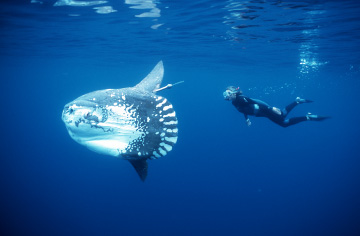Getting to know the heaviest bony fish in the world is surprisingly hard. At 3 m (10 ft) long and 2,200 kg (4,850 lb), the Mola mola, or ocean sunfish, is an elusive giant. A typical day in its life is still a mystery.
Now, a study published on 30 September in the Journal of Experimental Marine Biology and Ecology has opened a small portal onto their behaviors – and has underlined concerns that sunfish die in alarming numbers as unintentional catches in commercial fisheries.
There are scant details on sunfish populations partly because they are citizens of the open ocean. And despite being shaped like an enormous drifting dinner plate, sunfish are relatively active, the new study indicates.
Working off the coast of Japan, scientists tagged 12 young sunfish with satellite trackers to monitor their activities. The tags recorded location, water temperature and the depths of their dives. The data showed that sunfish do not move across entire oceans like tuna do, said study co-author Tierney Thys in an interview with mongabay.com. Thys, based in Carmel, California, is the founder and director of the Ocean Sunfish Tagging and Research program.

Tierney Thys, with the Ocean Sunfish Tagging and Research Program, checks a sunfish with a satellite tag inserted just below its dorsal fin. Photo by Mike Johnson. |
But sunfish do make seasonal forays into the open ocean. According to the study, individuals traveled northeast of Japan in the spring. One youngster traveled as far as 1700 km (1050 miles) offshore. Then, the fish headed back toward coastal Japan in late summer.
The data also showed that sunfish dove repeatedly throughout the day, presumably tracking deep-sea jellies, according to Thys and her colleagues. They sometimes went as deep as 171 m (564 ft).
Sunfish are both predator and prey in their open-ocean habitats, said Thys. Indeed, they are one of the few large animals that eat jellies. According to Thys, sunfish predators include sea lions, orcas and sharks. And sunfish can serve as “moving buffets” for cleaner fish that eat the parasites embedded in their giant bodies.
Cleaner fish are not the only ones making a meal off the sunfish. “Although the mola is not commercially important in the U.S., it is in Japan,” said Daniel Cartamil in an e-mail to mongabay.com. Cartamil, a researcher at the Scripps Institution of Oceanography, was not involved in the study.

The ocean sunfish (Mola mola), the world’s heaviest bony fish, can weigh up to 2,200 kg (4850 lbs). Photo by Mike Johnson. |
Sunfish are also caught accidentally. Thys and her colleagues referenced a study that estimated 340,000 sunfish a year are unintentionally caught in tuna and swordfish fisheries off of South Africa. They also said sunfish are the most common species accidentally caught in drift gillnet fisheries off of California and Oregon.
“Whether this represents a significant fraction of the total population is not known, but we do know it is wasteful,” said Cartamil.
To fill gaps in our knowledge of sunfish populations, Thys plans to tag more of them in the Galapagos Islands next summer. She wants a better understanding of that population “so we can better protect it,” she said.
For now, Cartamil said, “This is a good paper which provides us with another piece of the puzzle [about] mola habitat and movements.”
Citation: H. Dewar et al. Satellite tracking of jellyfish predator: Mola mola ocean sunfish. Journal of Experimental Marine Biology and Ecology, 30 Sept 2010 DOI: 10.1016/j.jembe.2010.06.023
Jane Lee is a graduate student in the Science Communication Program at the University of California, Santa Cruz.







